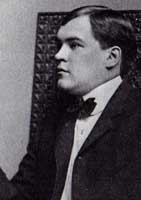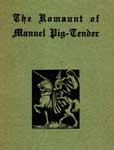The Silver Stallion
A Silver Stallion Special Feature No. 1:
Cabell and Machen Through the Decades - Three Essays

 As Mark Valentine points out in the final essay here, "There is indeed a significant divergence in the work of Machen and Cabell... [t]here are rewarding virtues in both of their canons, but they do not derive from similar visions.” Nonetheless, Cabell and Machen found each other genial correspondents, and quite a number of enthusiasts have embraced them both, from Vincent Starrett to, well, Mark Valentine. And so we are pleased to be able to reprint here classic essays spanning three generations of readers – from 1930, 1963, and 1999 -- which concern both the Welsh Wizard and the Wasp Wasp.
As Mark Valentine points out in the final essay here, "There is indeed a significant divergence in the work of Machen and Cabell... [t]here are rewarding virtues in both of their canons, but they do not derive from similar visions.” Nonetheless, Cabell and Machen found each other genial correspondents, and quite a number of enthusiasts have embraced them both, from Vincent Starrett to, well, Mark Valentine. And so we are pleased to be able to reprint here classic essays spanning three generations of readers – from 1930, 1963, and 1999 -- which concern both the Welsh Wizard and the Wasp Wasp.
Our first essay, "James Branch Cabell and Arthur Machen: Certain Analogies Between Their Early Works" is by Nathan van Patten (1887-1956), Director of Libraries and Professor of Bibliography at Stanford University in California. Dr. van Patten was also the first president of the American incarnation of the Arthur Machen Society, from 1948 until his death. The Machen-Cabell correspondence of 1918 was not widely known until the publication of Between Friends in 1962, so van Patten may not have been aware they corresponded, but still he detected resonances between these two enthusiasms of his -- though sometimes his comparisons resemble those of Machen's countryman Fluellen when he goes about to demonstrate the similarities between Alexander the Great and Henry V of England:
If you look in the maps of the 'orld, I warrant you sall find, in the comparisons between Macedon and Monmouth, that the situations, look you, is both alike. There is a river in Macedon; and there is also moreover a river at Monmouth: it is called Wye at Monmouth; but it is out of my prains what is the name of the other river; but 'tis all one, 'tis alike as my fingers is to my fingers, and there is salmons in both.
Shakespeare’s Henry V, Act IV, Scene vii
 The second essay is by Thomas Horan (1904-1982) of Georgia, USA, best known to Cabellians for his Romaunt of Manuel Pig-Tender, a cod-source for Figures of Earth. Horan was also a hardcore Machenian and operated his own ‘Poſtprandial Preſs’ where he issued truly limited editions of Machen1 and Cabell2. Horan and Cabell met occasionally through the years, and “Tea-Party at Poynton Lodge” is a record of one such encounter. Inevitably Cabell and Horan talked of Machen, about whom they enjoyed disagreeing. And it didn’t end there -- only two months before he died, Horan wrote to Harlan Umansky, associate editor of the Cabell studies journal Kalki,demanding to know the cause of the hiatus in its publication. “I’m ready to drop the whole thing and start re-reading the books of Arthur Machen again,” he threatened.
The second essay is by Thomas Horan (1904-1982) of Georgia, USA, best known to Cabellians for his Romaunt of Manuel Pig-Tender, a cod-source for Figures of Earth. Horan was also a hardcore Machenian and operated his own ‘Poſtprandial Preſs’ where he issued truly limited editions of Machen1 and Cabell2. Horan and Cabell met occasionally through the years, and “Tea-Party at Poynton Lodge” is a record of one such encounter. Inevitably Cabell and Horan talked of Machen, about whom they enjoyed disagreeing. And it didn’t end there -- only two months before he died, Horan wrote to Harlan Umansky, associate editor of the Cabell studies journal Kalki,demanding to know the cause of the hiatus in its publication. “I’m ready to drop the whole thing and start re-reading the books of Arthur Machen again,” he threatened.
The third essay, “James Branch Cabell and Arthur Machen” is by Mark Valentine, a name well-known to lovers of fantastic, supernatural and decadent fiction. He is editor of the journal Wormwood and numerous anthologies, biographer of Arthur Machen and Sarban, and an accomplished author in his own right (The Collected Connoisseur, and many others). Wearing his Machen hat he produced this insightful essay for Faunus, the journal of The Friends of Arthur Machen. (Check out the FoAM website here: http://www.arthurmachen.org.uk/ .)
Notes:
1. The Glitter of the Brook, 1932, limited to ten copies; A Receipt for Fine Prose, 1956, limited to two copies.
2. The Romaunt of Manuel Pig-Tender, 1931, first edition limited to ten copies, second edition limited to five hundred copies; There Was a Book, and There Were Trilogies, 1956, limited to two copies.